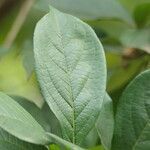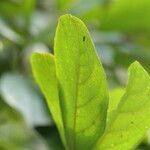Leaves alternate; petiole 2–5 cm. long, slender, canaliculate, glabrous; lamina 3.0–9.5 x 2.5–6.0 cm., lanceolate to widely ovate or elliptical, minutely rusty-tomentose on the very young leaves but glabrous on the mature ones, slightly discolorous, acute to acuminate, rarely obtuse at apex, obtuse to truncate, rarely acute but often asymmetrical at base, with crenate-serrate margins, papery, with 4–6 secondary nerves on each side of the midrib, not prominent on lower surface.
Tree or shrub, 2-10 m high; occasionally stunted. Leaves petiolate; blade ovate, 50-100 x 20-40 mm, base cuneate, apex long acuminate, margins irregularly finely toothed, glabrous; petioles up to 30 mm long. Flowers in scorpioid cymes. Calyx irregularly toothed. Corolla creamy white. Flowering time Aug.-Apr. Fruit a globose drupe, ± 15 mm long, orange.
Corolla whitish, yellowish or greenish; tube 2.5–3.5 mm. long, campanulate or tubular-campanulate, glabrous outside and inside save by some whitish hairs below the insertion of the stamens; lobes 4–5(6), 4.5–6.0 x 2.0–3.5 mm., lanceolate to oblanceolate, acute to obtuse at apex with the margins sinuate, glabrous, reflexed.
Ovary in male flowers c. 1.5 mm. long, globose to conical, in hermaphrodite flowers 2.0–2.5 mm. long, ovoid to obovoid, acute, glabrous; style in male flowers lacking, in hermaphrodite flowers 5.0–6.5 mm. long, first-forked at 0.5–1.5 mm. and with stigmatic branches c. 3 mm. long, linear-flattened.
Stamens 4–5(6), inserted at apex of the corolla tube; anthers 1.3–1.7(2.4) mm. long, oblong or ovate; filaments in male flowers very variable in length, even in the same panicle, usually 1.5–4.5 mm. long, in male flowers 1.8–2.2 mm. long, glabrous or slightly hairy at base.
Small tree or shrub, up to 7 m high. Leaves glabrous at maturity, crenate-serrate; petiole very slender. Panicles pubescent to glabrous, lax. Calyx in flower smooth. Corolla lobes longer than broad. Flowers whitish, yellowish or greenish.
Fruit c. 14 x 9 mm., ovoid, apiculate, glabrous, orange or red when ripe, surrounded at base by the widened cup-shaped calyx; pyrene c. 12 x 8 x 5 mm., laterally compressed, 1–2-seeded.
Shrub or small tree to 7 m. Leaves long-petioled, lanceolate to ovate, margins irregularly serrated. Flowers creamy white. Fruits fleshy, ovoid, in a cup-like calyx, orange or red.
Calyx 4–5 mm. long, tubular-campanulate, irregularly 3–5-toothed, membranous, minutely and sparsely pubescent outside, strigose inside mainly in the upper part.
Cymes arranged in a small lax panicle, terminal and often on short lateral branches; rhachis and branches at first pubescent, becoming glabrous.
Shrub or small tree up to 7 m. high, deciduous; branches greyish, glabrous; branchlets rusty-pubescent but soon glabrescent.
Flowers hermaphrodite and male on pedicels 1–5 mm. long; buds globose, at last obovoid.



